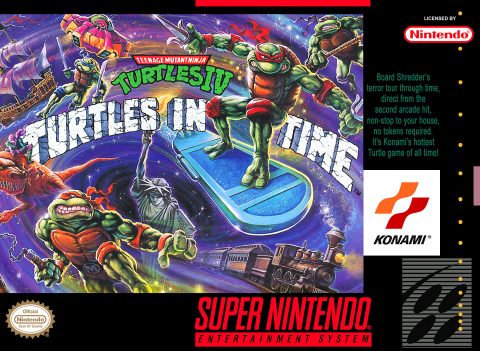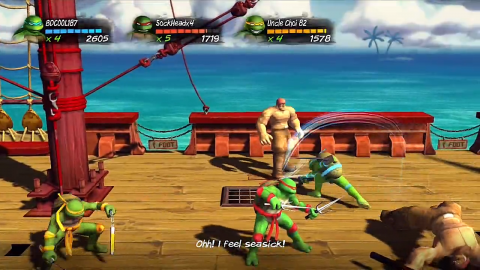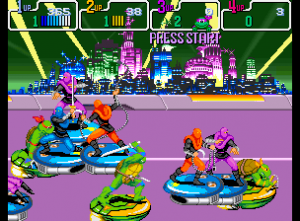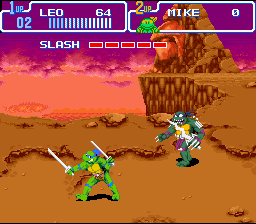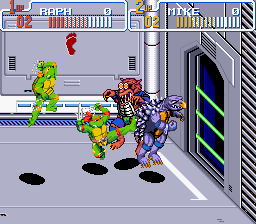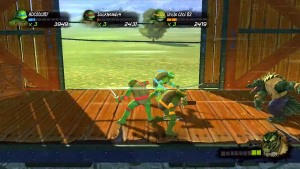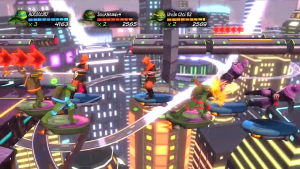- Teenage Mutant Ninja Turtles (NES)
- Teenage Mutant Ninja Turtles: The Arcade Game
- Teenage Mutant Ninja Turtles: World Tour
- Teenage Mutant Ninja Turtles: The Manhattan Missions
- Teenage Mutant Ninja Turtles III: The Manhattan Project
- Teenage Mutant Ninja Turtles: Turtles in Time
- Teenage Mutant Ninja Turtles: Hyperstone Heist
- Teenage Mutant Ninja Turtles: Fall of The Foot Clan
- Teenage Mutant Ninja Turtles II: Back From The Sewers
- Teenage Mutant Ninja Turtles III: Radical Rescue
- Teenage Mutant Ninja Turtles: Tournament Fighters (Genesis)
- Teenage Mutant Ninja Turtles: Tournament Fighters (SNES)
- Teenage Mutant Ninja Turtles: Tournament Fighters (NES)
- Teenage Mutant Ninja Turtles (Console – 2003)
- Teenage Mutant Ninja Turtles (GBA – 2003)
- Teenage Mutant Ninja Turtles 2: Battle Nexus (Consoles)
- Teenage Mutant Ninja Turtles 2: Battle Nexus (GBA)
- Teenage Mutant Ninja Turtles: Mutant Melee
- Teenage Mutant Ninja Turtles 3: Mutant Nightmare (Console)
- TMNT (2007) – Console
- TMNT (2007) – NDS and PSP
- Teenage Mutant Ninja Turtles 3: Mutant Nightmare (DS)
- TMNT (GBA)
- Teenage Mutant Ninja Turtles: Smash-Up
- Teenage Mutant Ninja Turtles: Arcade Attack
- Teenage Mutant Ninja Turtle (Plug and Play)
- Teenage Mutant Ninja Turtles Fast Forward: Ninja Training NYC / TMNT: Power of 4
- TMNT: Ninja Adventures – Mini-Game and Activity Centre
- Teenage Mutant Ninja Turtles: The Ninja Tribunal / The Shredder Reborn
- Teenage Mutant Ninja Turtles: Double Damage
Konami’s Teenage Mutant Ninja Turtles arcade game had been such a great success both critically and financially, that the sidescrolling brawler format was now assigned as the main template for a TMNT game. While the handheld and computer that were handled by different development heads and ideas did make use of some different types of game play, the main numbered sequels from Konami were now typecasted as brawlers. Near immediately after the release of The Arcade Game in 1989, Konami started the planning of the next game in the series.
Of course, the turtles had already gone through New York City one time too many to take down the Foot Clan, so this adventure needed to be even greater. So what to do? Time travel? Go into space? Take the fight to NYC yet again? Well actually, they went for all of them.
Turtles in Time was developed by the same team who were responsible for the first arcade game, and the engine remains the same though massively improved. Immensely impressive graphics, superior sound and the trademark four player simultaneous arcade action remained the center of its appeal, though there was more under the hood this time around than just the exterior charm and quality.
On a regular day with not much going on in the way of crime and evil doing, the turtles are relaxing in their sewer hideout watching Channel 6 news, as April ‘O Neal is reporting live from Liberty Island. It doesn’t take long before trouble is afoot when Krang comes on screen in his exosuit, literally picking up and stealing Lady Liberty. Shredder appears on screen to issue the young reptilians a challenge, and so they set off to follow the tracks through downtown NYC, only for them to fall into Shredder’s dubious set up, and sent back in time, way way back.
The story is simple enough, right in character with the TV show, which was still enjoying great success. While the first arcade game used the NYC cityscape as its setting, time travel is now the paint it uses to color its canvas, and the TMNT don’t just end up far back into the past, but also far into the future, giving a chance for a lot of varied stages and interesting enemies. Most of the mechanics from the first arcade game is brought over into the sequel, from enemy characters, controls and moveset. In total, four versions of the game were produced – the original arcade game, the SNES port, the PS2/Xbox port hidden away as a bonus in other games, and later on, the 2009 HD 3D remake.
The arcade game was released worldwide on September 18th, 1991, as part of a marketing event which included a new toyline (unrelated to the game) and a new season of the TV show which premiered only one week prior to the release of the arcade game.
There is now more diversity between the four brothers than before. Their general moveset remains mostly similar, though a few integral moves have been added. Most notable is the new “wham bam” grapple which is triggered by moving towards the enemy during the striking combo, and will result in the opponent smashed side to side (heavier enemies are simply thrown overhead). Another move is the characteristic screen throw, where a foot soldier is launched towards the screen, using a sprite scaling effect and is triggered at random. Each turtle also have more diversified strengths. Donatello’s reach and power is further enhanced, while Raphael’s speed is much greater than his brothers, though his attacks are generally weaker. Running can be triggered by holding the joystick either left or right for a second and be used to perform an all new shoulder block or rolling kick. Adding to the individual diversity of the four turtles, each of them have their very own special attacks when both jump and strike is pressed at the same time, at the expense of a little health.
The boosted moveset and abilities come in handy as the enemy roster is bumped up greatly both in the form of Foot Soldiers and all new bosses. Like before, Foot Soldiers come in different colors corresponding to their type of skill, with the different types being everything from bomb throwers to sword wielders. In addition to the Foot, familiar characters both old and new from the TV show cameo as bosses at the end of every stage and with the exception of Baxter Stockman, are all newcomers. Toka and Rahzar from the second live action movie make their video game debut, as well as Cement Man and Metal Head. Rocksteady, Bebop, General Traag and Granitor as absent this time around, though Traag’s Stone Warriors now appear as regular enemies. All characters, both playable and otherwise, now sport more frames resulting in much smoother animations, and the hit detection is improved to add more weight in each attack. Each boss have a sound bite quote before their battles, though it’s evident the voice cast for this game is not the one from the cartoon show.
The stages past the NYC starting locations are all time travel themed, throwing the Turtles into a specific period, going as far back as the age of the dinosaurs to Shredder’s starbase in 2100 AD. They also visit Neo Manhattan in the year 2020 AD, where roads curve and bend in sharp straight lines and everyone surfs on hoverboards. In between that and the hovering skateboards promised by 2015 in Back to the Future II, we’re certainly in luck when it comes to near future activities! There’s not much beyond the general stage themes in terms of diversity in the stage design, with most levels being the standard left to right brawler, in fact it doesn’t even have the obligatory elevator section that every beat-em-up is required to have by state law. There are a greater number of environmental hazards however, from loose planks to freeze beams. The futuristic surf stage also acts as a pizza bonus level.
Interestingly, Splinter shows a bit of a meanstreak in this game, serving as the timekeeper for each stage and ushering the turtles to move on if they stand still. Each time Splinter appears, he grows larger in size, and eventually if players have not moved within the alloted time, he drops a lethal bomb on each of them, killing them in the process. This was most likely done in order to circumvent people walking by and stumbling on an abandoned machine with credits left on it.
The stages themselves become this game’s greatest weakness, when it should have been its strength. Primed with potential of expanding its enemy roster to make use of period appropriate familiars and truly make for a colorful, dynamic adventure, most if not all the stages are extremely dull and in ways lazily done with very little, at times absolutely no effort made into make them seem period appropriate. An example; the dinosaur stage. When traveling 25,000,000 back in the past, you’d expect to see some of the tourists spots and meet some of the locals, but the Konami tour bus decides to take you through the ghetto, in the most barren part of the outskirts, only to see a cave and four dinosaurs which run by at the speed of light. Most of the time spent in this time period is spent inside a purple tinted cave, fighting electronic robots and stone warriors from another dimension. By this time, the Triceratons had even appeared in the TV show and could have easily fit in perfectly, even if only as a boss, which also sticks out like a sore thumb, being Cement Man who appeared less than 45 seconds in one episode of the TV show.
The wild west is also poorly represented, taking place on an open carriage train across the countryside. Though some of the Foot Soldiers this time have been given ponchos and sombreros along with some circus equipment, the train has little to give a feel of the wild west. What makes this ill representation even more puzzling is that Sunset Riders, Konami’s classic wild west themed shooting game, was developed side by side and using the same technology as Turtles in Time, featuring much more vivid locations. The pirate ship suffers from much of the same issues, though the fact that it is out on sea and some ships are seen in the background does provide a bit more appropriate scenery. The only level that really feels special is the two last levels, set in the future, with its fusion music and awesome cyberpunk flaunting setting makes for a audio and visual treat.
The soundtrack was again handled by Izumi, the man who had earlier been responsible for the first Arcade game, and gone on to score a number of the Western franchise based arcade games Konami was putting out at the time. With its charming pop rock sound often based around the main cartoon’s theme song, it’s come to be remembered as one of the best arcade game soundtracks of all time. The music might be the only thing that stays consistent and focused on each time period as well, integrating some musical elements that feel more proper to the setting at times. Most arcade goers also fondly remember the attract music, Pizza Power, which was taken from the Coming Out Of Their Shells concert tour recording released a year earlier. Portions of the soundtrack was released on Konami All-Stars 1993: Music Station of Dreams in 1992, slightly upsampled.
Unlockable in the game Teenage Mutant Ninja Turtles: Mutant Nightmare released in 2005, this emulated port is graphically faithful to the arcade version, though several changes had to be made because of licensing issues. The iconic soundtrack was changed, just like it had been with the unlockable in Battle Nexus, and uses music from the 2003 cartoon series. All the voice clips were rerecorded by the 2003 cast as well. While the changes due to licensing are maybe justified, there are several flaws that are not so welcome and understandable. Frame rate issues come at random places, seemingly unaffected by what’s actually going on in the game but rather the emulator is coded poorly, there is no score counter to be found, and PS2 owners got the short end of the stick as the emulator assigns each controller port to a character. For the GameCube and Xbox, this means all four turtles can be used depending on which port the controller is plugged into, however the PlayStation 2 only has two ports, rendering Donatello and Raphael unplayable. However, this can be remedied by using a multitap.
One thing is for sure however, and that is that from start to finish with some friends, the game is still an absolute blast and still one of the most fun arcade multiplayer games ever made. The humor, facial expressions and music all feel authentic and the action is non stop with a never ending surge of Foot Soldiers and challenging boss battles. Though sometimes criticized as too short, it is rather at perfect length for an arcade brawler where 2-4 people to stand around a single unit. The action and gameplay does make up for most of the flaws that can be found in its stage design, though after a few playthroughs, the bland locations start to seep through.
An interesting bit of trivia is the fact that one of the stages is subtitled “Where No Turtle Has Gone Before”, obviously riffing on Star Trek‘s famous title sequence monologue. Two years later a toyline crossover between Star Trek and TMNT was made with this subtitle attached.
SNES Version
The only port made for Turtles in Time before 2005 was released exclusively on the SNES in summer of 1992, and now retitled Teenage Mutant Ninja Turtles IV: Turtles in Time, placing it into the numbered sequel line since the NES brawler, Teenage Mutant Ninja Turtles III: Manhattan Project had been released February of that year. This led to some naming confusion in Europe, since the third NES game was never released in that region. The Japanese game omitted the numbering completely, due to TMNT III being known as II, and Konami opted not to confuse gamers further. Like Teenage Mutant Ninja Turtles II: The Arcade Game, the Super Nintendo port would see a number of enhancements and new additions not found in the original arcade game. In Europe, it was released in winter of 1992, in time for the Holiday season.
The overall game, from controls to graphics remain nearly identical to the arcade versions, losing very little in the way of detail or sound, in fact it has even been improved upon despite the weaker tech. The most major change to the controls is that the throws have now been made an executable move rather than a randomly occurring one, done by timing both the strike button and down on the D-pad in place of the final strike. Unfortunately the scaling effect looks choppier in the SNES version. There is also a button dedicated to running, which would happen automatically in the arcade version if you walked forward for a few seconds.
The SNES port also sports several new enemies and boss characters and an all new stage, along with some being lengthened. The new bosses include Slash, Rocksteady, Bebop, Rat King and Shredder’s robot suit. Shredder also sports a new makeover in the climatic final battle of the game. The all new stage is the return of the Technodrome, sorely missed from the arcade version, and styled very much from its design in the first arcade game. The boss layout has been changed to accommodate for extra level, so in the SNES version, Tohka and Rahzar appear as midstage bosses inside the Technodrome, while Rocksteady and Bebop take their places on the pirate ship, sporting dashing pirate attire. Another greatly missed brawler institution is reinstated into the game, the rising elevator, leading to an early showdown with Shredder. The sewer surfing stage, originally done as a short bridging point into the time traveling plot, is retooled as a bonus stage with Rat King riding a footski as the boss. Neon Nightriders, the futuristic surfing stage, now sports extensive Mode 7 twists and turns, turning it into a much more elaborate stage as well. Mode 7 was also used in a very creative boss battle, being the one with Shredder in the Technodrome, where Shredder’s robotic suit is situated in the forefront of the screen, requiring the turtles to perform the screen throw to hurt him.
Some things went missing in transition however, Cement Man is now completely replaced by Slash, not to be seen anywhere, and several animation frames are cut due to memory constraints. Most of the sound bytes, including all of the boss quotes are missing, and Pizza Power is also omitted, replaced with the instrumental rendition of the TV show theme. The four player option is also gone as with the original arcade game port, allowing only for two players. Some of the stages in the arcade version also had small intros and outros showing some scenery and interesting details, which has been left out on the SNES. April also takes Splinter’s place as the timekeeper for each stage, but does not choose to kill off her friends in this game like Splinter did.
Konami added an additional 1-on-1 fighting mode into the game, allowing two players to go head to head with the turtle of their choice under the watchful eye of Master Splinter. Due to the small moveset compared to actual fighting games, it doesn’t play very smoothly, and is quickly forgotten. There is also a time trial mode, and the option to use the Adventures comic book skin tones is available. The game’s true ending can only be achieved by finishing the game on Normal or above. The overall game has been toned down in difficulty due to the option being available to make it either easier or harder.
Even with the loss of the four-player option, the numerous extras and care taken into the SNES port makes it a fantastic game and better than its arcade counterpart, being a shining example of how to handle ports back in that era of gaming. The length is perfect for the genre, the music is brought over with some arrangements to the sound to make it sound even better, and the graphics are as colorful and imaginary as they seemed on the arcade monitor. The time travel is still poorly realized, and the extra level being set in contemporary times doesn’t do much to remedy this fact.
Comparison Screenshots

Arcade

SNES

Arcade

SNES

Arcade

SNES

Arcade

SNES

Arcade

SNES
Teenage Mutant Ninja Turtles: Turtles in Time Re-Shelled – PlayStation 3, XBox 360 (2009)
Corresponding with the release of the 2007 movie, Ubisoft created a unique deal with Konami to sublicense The Arcade Game for release on the Xbox Live Arcade download service, and tie it with the new motion picture loosely based on the 2007 materials. This was also a necessity due to much of the music and voice clips taken from the 1987 series being owned by the Fred Wolf Group. The 1989 arcade classic became one of the most popular downloadable titles on the service and would rank in the top 10 for a great period of time, with Ubisoft and Konami splitting the revenue and at one point also extending their contract for that particular game in order to keep it available. The success of the 1989 arcade game on XBLA proved that even with the potentially deal breaking changes made to the sounds and art, fans were still embracing the genre and the characters like never before, and that would eventually inspired Ubisoft to not only provide more TMNT action, but also attempt to give it their own spin.
While the response for the 1989 game was favorable, it also came with a massive wave of demand and requests to bring Turtles in Time onto Live Arcade. Ubisoft however had learned one things from the release of Arcade Game, that they were not interested in yet again splitting profit with another company. To most fans’ surprise when Turtles in Time was finally announced for a rerelease, they would not be getting the classic game simply upscaled and online enabled, this time, they were getting a complete 3D remake. This in turn would give the game greater marketing opportunities and allow for Ubisoft to completely bypass Konami, since the actual likenesses and storylines were owned by Mirage Studios. The game received a new subtitle, Re-Shelled, a play on the naming scheme given to Capcom’s Bionic Commando Rearmed from 2008.
Turtles in Time Re-Shelled is still very much grounded in the design from the arcade game and adheres to most of the same designs. Set on a fixed 2.5D playfield, Re-Shelled is a one to four player beat-em-up where the Ninja Turtles once again has to bring back the Statue of Liberty and are sent through time by a trap set by Shredder. Battalions of Foot Clan warriors fill up the screen constantly for melee mayhem and at the end of each stage wait a boss, before the two toed bros can venture on through time in order to find Shredder and Krang.
Unlike the 1991 game however, attacks can now be done in all 8 directions, allowing for full 3D combat. Controls remains mostly identical to the arcade release rather than the revised SNES scheme, so throws aren’t as easy to pull off, but it does add a run button. Moves are recreated in 3D without much change from how it looked in 2D. The stages’ structure will be instantly recognizable as well as each backdrop has been recreated as experienced in the original, though with more visual presentation overall.
It’s in the exteriors that most of the significant changes can be seen and felt. One of the major issues felt in the original is the lack of proper use of the opportunities the time travel plot presents, and backgrounds being largely uninspired. In Re-Shelled, the designers have actually taken the opportunity to give each stage a much more distinct feeling along with greater depth. In the distance you’ll see jungles, islands, huts, which might feel like rather small visual improvements, but it is the smaller detail that gives the greater atmosphere. The train stage really benefits from this, with gusts of strong winds and blurring effects to more properly illustrate the speed of the train and the background scenery changing from rivers to grass lands and nature. The prehistoric level also looks closer to being actually set in prehistoric times rather than largely just taking place within a cave.
The update in visuals don’t travel quite as far in near all other areas however. Re-Shelled suffers greatly from the law that every game made after 2004 must have faded colors, preferably with a overcasting tint rather tham making the game stand out with the use of actual colors. Turtles in Time were a colorful delight with great scenery, primitive coloring and charismatic characters. Re-Shelled on the other hand becomes entirely too dark and tones down the use of color significantly, making the New York stages much more industrial than what one might remember from the 1991 game. There are also moments of some weird filtering used on some of the stages, like the Sewer Surfin’ stage which now is gulping green for no real reason other than obstructing the details in the graphics. The physics in Re-Shelledare also exceptionally weak, making the whole game feel like it has no weight whatsoever, and the strikes looks like something with the strength that would have trouble cutting melted butter.
The artstyle has been retooled completely, using the leaner body tone of the 2007 movie combined with the 2003 cartoon characteristics, and all of the supporting boss characters have been given a redesign, as have the cutscenes of the game. The artstyle is more in line with fanart made for deviant art than it is for an official video game, and all the characters come with an unnecessary amount of exaggeration even for TMNT, and the illustrations especially look very amateurish in the way it is colored. The turtles themselves look fine, though their headbands seemed to have been washed together and faded in color. You’re always supposed to separate dark from light colors.
What really limits the game the most is the length and lack of any real updates to the core game. Even though the action takes place in 3D and in multiple directions, the game doesn’t make any use of this to do anything new, essentially complicating the combat for no real reason as the eight directions means the attack needs to be accurately lined up. Even though the visual look to each stage has improved, the length, enemy activators and boss battles are exactly the same. The most common fan complaint is that the game is based on the much shorter arcade version rather than the SNES version with its extra levels and content. The specific content added to the SNES game is actually locked in a deal signed with Nintendo to make the game exclusive for the console, and Ubisoft would have to sought permission from them to base it on that particular version so it is understandable they did not go that route, but it doesn’t really excuse the fact that they didn’t add anything new at all besides the online play and a few achievements.
That’s really the problem Ubisoft ran into with the 2007 game as well, the inability to go beyond what is already done and rely too much on the standard set by the inspiration. Re-Shelled is a game that really needs to be packed to the gills with innovative ideas and ways to renew the original game, because without the classic visuals and music, fans won’t look at this 3D remake with the same set of goggles that they would with a direct port, as a port would be able to hide its weaknesses behind being of age and nostalgic qualities, while Re-Shelled time and time again points at its own limitations. It’s a 3D brawler in 2009 with unremarkable graphics, limited movesets and curious art design changes, not to mention a hilariously weak low key fusion soundtrack that is such an opposite from the original that it becomes offensive. Both the music and voice clips is of very low quality.
While Re-Shelled is mediocre, it is only made to look worse by bearing the name of an all time classic that it can’t live up to, due to the fact that it relies on mechanics that were already facing some fatigue in 1991 and in 2009 only becomes wholly shallow. Regardless, it sold relatively well and topped the download charts after its release, and seemed to find a stronger footing with the younger audiences that weren’t familiar with the original game, but rather just enjoyed a simplistic brawler.
Re-Shelled was delisted from both PSN and XBLA in July of 2011 due to the licensing deal with the Fred Wolf Group expiring along with the fact that the TMNT franchise was sold to Nickelodeon in late 2009, resulting in all the pre-existing deals to be renegotiated in order to be extended further. It is unlikely the game will return to either service.
Comparison Screenshots

Arcade

SNES
Xbox 360

Arcade

SNES
Xbox 360

Arcade

SNES
Xbox 360




